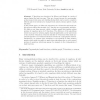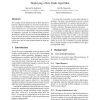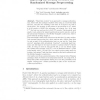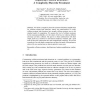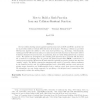FSE
2005
Springer
15 years 13 days ago
2005
Springer
T-functions were introduced by Klimov and Shamir in a series of papers during the last few years. They are of great interest for cryptography as they may provide some new building ...
EUROCRYPT
2005
Springer
15 years 13 days ago
2005
Springer
Abstract. MD5 is one of the most widely used cryptographic hash functions nowadays. It was designed in 1992 as an improvement of MD4, and its security was widely studied since then...
EUROCRYPT
2005
Springer
15 years 13 days ago
2005
Springer
MD4 is a hash function developed by Rivest in 1990. It serves as the basis for most of the dedicated hash functions such as MD5, SHAx, RIPEMD, and HAVAL. In 1996, Dobbertin showed ...
ICMCS
2005
IEEE
15 years 15 days ago
2005
IEEE
This paper describes a counter scheme that uses hash functions to count how many times the user is allowed to play protected content in a DRM-enabled player. The proposed basic sc...
ACNS
2006
Springer
15 years 27 days ago
2006
Springer
We study the influence of collision-finding attacks on the security of time-stamping schemes. We distinguish between client-side hash functions used to shorten the documents befo...
NDSS
2006
IEEE
15 years 27 days ago
2006
IEEE
The strength of hash functions such as MD5 and SHA-1 has been called into question as a result of recent discoveries. Regardless of whether or not it is necessary to move away fro...
FSE
2007
Springer
15 years 1 months ago
2007
Springer
In this paper we propose the Grindahl hash functions, which are based on components of the Rijndael algorithm. To make collision search sufficiently difficult, this design has the...
FSE
2007
Springer
15 years 1 months ago
2007
Springer
Abstract. “Hash then encrypt” is an approach to message authentication, where first the message is hashed down using an ε-universal hash function, and then the resulting k-bi...
CRYPTO
2007
Springer
15 years 1 months ago
2007
Springer
We initiate a complexity-theoretic treatment of hardness amplification for collision-resistant hash functions, namely the transformation of weakly collision-resistant hash functio...
ASIACRYPT
2007
Springer
15 years 1 months ago
2007
Springer
Recent collision-finding attacks against hash functions such as MD5 and SHA-1 motivate the use of provably collision-resistant (CR) functions in their place. Finding a collision ...
